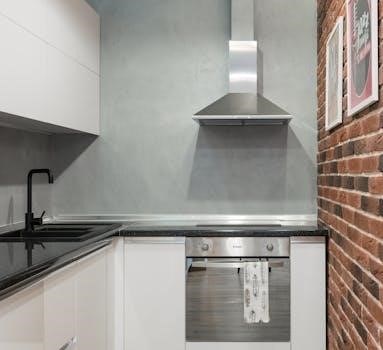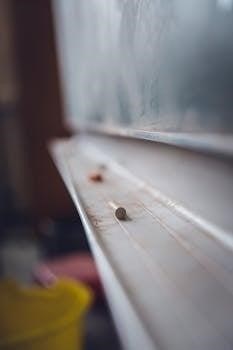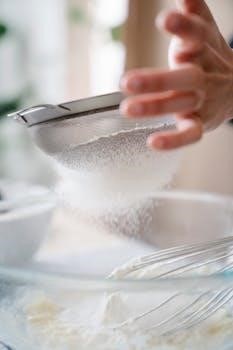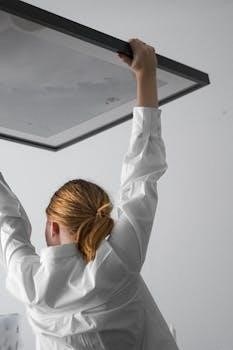
Maintaining a clean Viking oven ensures optimal performance and longevity․ This guide provides comprehensive instructions for cleaning your Viking oven, from preparing the appliance to selecting appropriate cleaning products․ We’ll cover essential steps, including removing accessories, cleaning the exterior, and addressing grates and burner caps․
Preparation Before Cleaning
Before initiating the cleaning process for your Viking oven, meticulous preparation is crucial․ Begin by ensuring the oven is completely cool to prevent any accidental burns or injuries during handling․ This cooling period might take a few hours, so patience is key․ Next, disconnect the oven from its power source, either by unplugging it or switching off the corresponding circuit breaker, to eliminate any electrical hazards․

Remove all internal components from the oven cavity, including oven racks, broiler pans, broiler grids, and any other utensils or accessories that may be present․ These items will be cleaned separately․ Clear the area around the oven, ensuring sufficient workspace and protection for your flooring․ Lay down old newspapers or cloths to catch any drips or spills during the cleaning process․
Proper ventilation is essential, so open windows and doors to circulate fresh air, especially if you plan to use chemical cleaners․ Consider wearing gloves to protect your hands from harsh cleaning agents and potential grease․ With these preparatory steps completed, you’re ready to move on to the actual cleaning process․
Removing Oven Racks and Accessories
The first hands-on step in cleaning your Viking oven involves the careful removal of all interior components․ Begin with the oven racks, gently sliding them out one by one․ Take note of their original positions to ensure proper replacement later․ Set the racks aside in a sink or large basin filled with warm, soapy water to soak while you address the oven’s interior․
Next, remove any other accessories such as broiler pans, broiler grids, or baking stones․ These items can typically be lifted out or slid off their supports․ Handle them with care, as they may be coated in baked-on grease and food particles․ Place these accessories in the same soapy water solution as the racks, allowing them to soak and loosen any stubborn residue․
Ensure that all removable parts are accounted for before proceeding․ Removing these components not only facilitates a more thorough cleaning of the oven interior but also allows you to clean these items separately, preventing further mess within the oven itself․ This step is critical for effective cleaning․
Cleaning the Oven Exterior
Once you’ve prepared the oven’s interior by removing racks and accessories, turn your attention to cleaning the exterior surfaces․ Begin by gathering your supplies⁚ warm soapy water, a soft cloth, and a microfiber cloth for drying․ Dampen the soft cloth with the soapy water, ensuring it’s not overly saturated, and gently wipe down the oven door, side panels, and control panel․ Pay attention to areas prone to grease splatters and fingerprints․
For stubborn stains or stuck-on food residue, allow the soapy water to sit on the affected area for a few minutes before gently scrubbing․ Avoid using abrasive cleaners or scouring pads, as these can damage the oven’s finish․ Instead, opt for a non-scratch scrub pad or a paste made from baking soda and water for particularly tough spots․ Always rub in the direction of the grain/brushed finish․
After wiping down all exterior surfaces, use a clean, damp microfiber cloth to remove any remaining soap residue․ Finally, dry the entire exterior with a dry microfiber cloth to prevent water spots and maintain the oven’s shine․ Regular cleaning of the oven exterior will help keep it looking its best․
Using Warm Soapy Water
Warm soapy water is a versatile and effective cleaning solution for various parts of your Viking oven, especially the exterior surfaces․ Prepare your solution by mixing a mild dish soap with warm water in a clean bucket or container․ The water should be warm, not hot, to prevent damage to certain surfaces and to be comfortable to handle․
Dip a soft cloth or sponge into the soapy water, ensuring it’s damp but not dripping․ Gently wipe down the oven’s exterior, including the door, side panels, and control panel․ For areas with grease or food splatters, allow the soapy water to sit for a few minutes to loosen the grime before wiping․ A blue Scotch-Brite pad, some Soft Scrub cleanser without bleach, and some soapy water can be used to help․
Rinse the cloth or sponge frequently in clean water to remove any dirt or debris picked up from the oven․ After wiping all surfaces with the soapy water, use a clean, damp cloth to rinse away any soap residue․ Finally, dry the surfaces with a clean, dry microfiber cloth to prevent water spots and leave a sparkling finish․ This simple method can keep your oven looking its best․

Drying with a Microfiber Cloth
After cleaning your Viking oven with warm soapy water or other cleaning solutions, drying it thoroughly with a microfiber cloth is an essential step․ This prevents water spots and streaks from forming on the surfaces, ensuring a pristine and polished finish․ Microfiber cloths are ideal due to their exceptional absorbency and lint-free nature․
Use a clean, dry microfiber cloth to gently wipe down all the surfaces you have cleaned․ Apply light pressure and work in small, overlapping sections to ensure complete coverage․ Pay special attention to areas where water may pool, such as around knobs, handles, and edges․ For stainless steel surfaces, wipe in the direction of the grain to avoid streaks and maintain the brushed finish․
Regularly check the microfiber cloth for saturation and replace it with a clean, dry one as needed․ A dry surface is key to preventing corrosion and maintaining the overall appearance of your Viking oven․ This simple step will leave your oven looking spotless and well-maintained, complementing your kitchen’s aesthetic․
Cleaning Oven Grates and Burner Caps

Maintaining clean oven grates and burner caps is crucial for optimal cooking performance and a presentable Viking oven․ These components often accumulate food residue, grease, and grime, which can affect heat distribution and potentially cause unpleasant odors․ Regular cleaning is essential to prevent buildup and ensure efficient operation․
Begin by removing the grates and burner caps from the oven․ For lightly soiled items, use a moist sponge and warm, soapy water to scrub away any residue․ For more stubborn stains, consider using a non-abrasive cleanser, such as Soft Scrub without bleach, along with a blue Scotch-Brite pad for gentle scrubbing․ Avoid harsh chemicals or abrasive materials that could damage the finish․
After cleaning, rinse the grates and burner caps thoroughly with clean water to remove all traces of soap or cleanser․ Ensure they are completely dry before placing them back in the oven․ This prevents water spots and potential corrosion․ By keeping these components clean, you’ll improve your oven’s performance and maintain its pristine appearance․
Using a Moist Sponge
Employing a moist sponge is a fundamental technique for cleaning various parts of your Viking oven, offering a gentle yet effective method for removing spills, splatters, and light residue․ This approach is particularly suitable for surfaces that are not heavily soiled or for routine maintenance cleaning․
Before using a moist sponge, ensure it is clean and free from any abrasive particles that could scratch the oven’s surfaces․ Dampen the sponge with warm water, wringing out any excess to prevent dripping․ Gently wipe down the interior walls, door, and other accessible areas of the oven, focusing on areas with visible stains or residue․
For more stubborn spots, consider adding a mild dish soap to the sponge, creating a soapy solution that can help loosen grime․ Avoid using excessive force or abrasive scrubbing, as this could damage the oven’s finish․ After wiping with the moist sponge, follow up with a clean, dry microfiber cloth to remove any remaining moisture and leave the surfaces sparkling clean․ Regular use of a moist sponge will keep your Viking oven looking its best․
Approved Cleaning Products
Selecting the right cleaning products is crucial for maintaining your Viking oven’s appearance and performance while preventing damage to its surfaces․ Using harsh chemicals or abrasive cleaners can lead to scratches, discoloration, or even functional problems․ Therefore, it’s essential to choose approved cleaning products specifically designed for use on Viking appliances․
For general cleaning, warm, soapy water is often sufficient for removing grease and fingerprints from the exterior surfaces․ A mild dish soap mixed with water can effectively clean the doors and handles without causing harm․ When dealing with tougher stains or baked-on residue, consider using a specialized oven cleaner that is specifically formulated for use on stainless steel and enamel surfaces․
Always read the product label carefully and follow the manufacturer’s instructions to avoid any adverse reactions․ Before applying any cleaning product to the entire oven, test it on a small, inconspicuous area to ensure it doesn’t cause discoloration or damage․ By using approved cleaning products and following proper cleaning techniques, you can keep your Viking oven looking and functioning like new for years to come․
Easy-Off Oven Cleaner
Easy-Off is a popular choice for tackling tough, baked-on grease and food residue inside ovens․ When using Easy-Off on your Viking oven, it’s crucial to follow safety precautions and the manufacturer’s instructions carefully․ Before applying the cleaner, ensure the oven is turned off and completely cool․ Remove the oven racks and any other removable accessories․
Protect the surrounding surfaces by placing newspaper or a drop cloth underneath the oven․ Wear gloves and eye protection to prevent skin and eye irritation․ Apply Easy-Off evenly to the interior surfaces of the oven, avoiding the heating elements and any painted or decorative areas․ Close the oven door and let the cleaner sit for the recommended time, typically a few hours or overnight for heavily soiled ovens․
After the soaking period, wipe the oven interior thoroughly with a damp sponge or cloth, rinsing frequently with clean water․ Ensure all traces of the cleaner are removed․ For stubborn residue, you may need to repeat the cleaning process․ Once the oven is clean and dry, replace the racks and accessories․ Always ventilate the area well during and after using Easy-Off․
Cleaning a Viking Range Griddle
Maintaining a clean Viking range griddle is essential for optimal cooking performance and preventing food buildup․ Regular cleaning after each use will keep your griddle in top condition․ Begin by scraping off any excess food particles with a metal spatula or scraper while the griddle is still warm․ Be careful not to scratch the surface․
Next, pour a small amount of warm water onto the griddle surface and use a grill brush or abrasive pad to scrub away any remaining residue․ For stubborn grease or burnt-on food, you can use a specialized griddle cleaner or a mixture of warm water and mild dish soap․ Ensure the cleaner is safe for use on stainless steel or chrome surfaces, depending on your griddle’s material․
After scrubbing, wipe the griddle clean with a damp cloth, rinsing frequently․ Dry the griddle thoroughly with a clean towel to prevent rusting․ To maintain the griddle’s seasoning, lightly coat the surface with cooking oil after cleaning and drying․ Heat the griddle on low heat for a few minutes to allow the oil to penetrate the surface․
Removing Protective Coating
Before using a new Viking range or rangetop griddle for the first time, it’s crucial to remove the protective coating applied during manufacturing․ This coating, often a thin layer of oil or wax, is designed to prevent rust and damage during shipping and storage․ Failure to remove it can result in unpleasant flavors and odors during cooking․
To remove the protective coating, begin by scrubbing the griddle plate thoroughly with a mixture of one quart of warm water and a mild dish soap․ Use a non-abrasive scrub pad or sponge to avoid scratching the surface․ Ensure you reach all areas of the griddle, including the edges and corners․
Rinse the griddle plate completely with clean, warm water to remove any remaining soap residue․ Dry the griddle thoroughly with a clean towel․ Once dry, inspect the surface to ensure all traces of the protective coating have been removed․ If any residue remains, repeat the cleaning process until the griddle is completely clean․ Proceed to seasoning the griddle after the coating is fully removed․
Seasoning the Griddle
Seasoning a Viking range griddle is essential for creating a non-stick surface and preventing rust․ This process involves applying a thin layer of oil and heating it, forming a protective barrier that improves cooking performance and extends the griddle’s lifespan․ Proper seasoning ensures food releases easily and the griddle remains in excellent condition․
To begin, ensure the griddle is clean and completely dry․ Apply a thin, even layer of high-heat cooking oil, such as canola or flaxseed oil, to the entire surface of the griddle․ Use a clean cloth or paper towel to spread the oil, wiping away any excess to leave only a very light coating․ Excess oil can become sticky and create an uneven surface․
Heat the griddle over medium heat until the oil begins to smoke lightly․ Continue heating for about 15-20 minutes, allowing the oil to polymerize and bond to the griddle surface․ Turn off the heat and let the griddle cool completely․ Repeat this process two to three times to build a strong, durable seasoning layer․ Regular use and maintenance will further enhance the seasoning over time․
Avoiding Harsh Chemicals
When cleaning a Viking oven, it’s crucial to avoid harsh chemicals that can damage the appliance’s surfaces and pose health risks․ Abrasive cleaners, bleach, and ammonia-based products can corrode the oven’s interior, discolor stainless steel exteriors, and leave behind noxious fumes․ Using gentler, more natural cleaning solutions is often just as effective and much safer for both your oven and your family․
Instead of harsh chemicals, consider using warm, soapy water for general cleaning․ A mixture of water and mild dish soap can effectively remove grease and food splatters from the oven’s exterior and interior․ For tougher stains, try a paste made from baking soda and water․ Apply the paste to the affected area, let it sit for a while, and then scrub gently with a soft cloth or sponge․
Vinegar is another excellent natural cleaner․ A solution of equal parts vinegar and water can help dissolve grease and grime․ Always ensure proper ventilation when cleaning your oven, and thoroughly rinse any surfaces that have been cleaned with a cleaning solution to remove any residue․ By choosing gentle cleaning methods, you can maintain your Viking oven’s appearance and performance without compromising your health or the appliance’s integrity․



